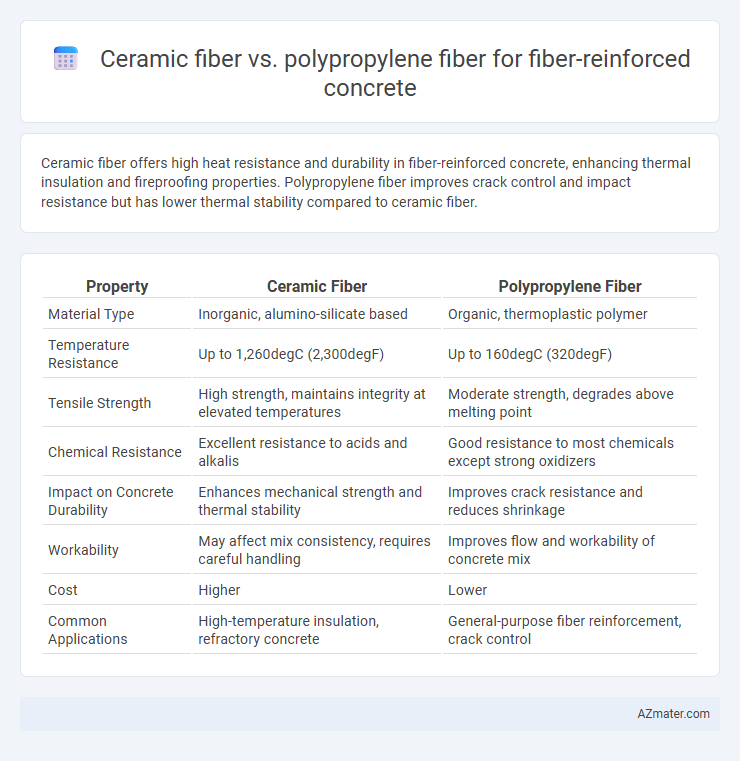Ceramic fiber offers high heat resistance and durability in fiber-reinforced concrete, enhancing thermal insulation and fireproofing properties. Polypropylene fiber improves crack control and impact resistance but has lower thermal stability compared to ceramic fiber.
Table of Comparison
| Property | Ceramic Fiber | Polypropylene Fiber |
|---|---|---|
| Material Type | Inorganic, alumino-silicate based | Organic, thermoplastic polymer |
| Temperature Resistance | Up to 1,260degC (2,300degF) | Up to 160degC (320degF) |
| Tensile Strength | High strength, maintains integrity at elevated temperatures | Moderate strength, degrades above melting point |
| Chemical Resistance | Excellent resistance to acids and alkalis | Good resistance to most chemicals except strong oxidizers |
| Impact on Concrete Durability | Enhances mechanical strength and thermal stability | Improves crack resistance and reduces shrinkage |
| Workability | May affect mix consistency, requires careful handling | Improves flow and workability of concrete mix |
| Cost | Higher | Lower |
| Common Applications | High-temperature insulation, refractory concrete | General-purpose fiber reinforcement, crack control |
Introduction to Fiber-Reinforced Concrete
Fiber-reinforced concrete (FRC) enhances structural performance by incorporating fibers to improve tensile strength, crack resistance, and durability. Ceramic fiber offers superior heat resistance and mechanical strength, making it ideal for high-temperature or aggressive environments, while polypropylene fiber provides cost-effective crack control, excellent chemical resistance, and improved workability in typical construction applications. Selecting the appropriate fiber depends on project requirements, with ceramic fibers suited for thermal and structural demands and polypropylene fibers preferred for general reinforcement and shrinkage control.
Overview of Ceramic Fiber
Ceramic fiber in fiber-reinforced concrete provides excellent thermal resistance and high-temperature stability, making it ideal for applications exposed to extreme heat. Its low thermal conductivity and chemical inertness enhance the durability and structural integrity of concrete under fire conditions. Unlike polypropylene fiber, ceramic fiber maintains strength without melting or degrading, ensuring long-term performance in high-temperature environments.
Overview of Polypropylene Fiber
Polypropylene fiber is a synthetic polymer widely used in fiber-reinforced concrete due to its excellent durability, chemical resistance, and cost-effectiveness. It improves concrete's resistance to plastic shrinkage cracking and enhances toughness without significantly affecting workability. Compared to ceramic fiber, polypropylene fiber offers better flexibility and impact resistance, making it suitable for a variety of construction applications.
Mechanical Properties Comparison
Ceramic fiber in fiber-reinforced concrete enhances tensile strength, thermal stability, and crack resistance, making it ideal for high-temperature and structural applications. Polypropylene fiber improves impact resistance, toughness, and controls plastic shrinkage cracking but offers lower tensile strength and stiffness compared to ceramic fiber. The mechanical properties of ceramic fiber provide superior durability and load-bearing capacity, while polypropylene fiber excels in flexibility and cost-effectiveness for general concrete reinforcement.
Durability and Chemical Resistance
Ceramic fiber exhibits superior durability and chemical resistance in fiber-reinforced concrete compared to polypropylene fiber, maintaining structural integrity in high-temperature and aggressive chemical environments. Polypropylene fiber offers moderate chemical resistance but degrades under extreme heat and acidic or alkaline conditions, reducing long-term performance. The high melting point and inert nature of ceramic fibers make them ideal for applications requiring enhanced durability and resistance to corrosive agents.
Thermal Performance Differences
Ceramic fiber exhibits superior thermal resistance with the ability to withstand temperatures exceeding 1200degC, making it ideal for fiber-reinforced concrete applications requiring high heat durability. Polypropylene fiber, by contrast, melts at approximately 160-170degC, offering thermal protection primarily through melt-induced micro-voids that reduce spalling during moderate fire exposure. The high melting point and thermal insulation properties of ceramic fiber contribute to enhanced structural integrity under extreme thermal stress compared to the lower-temperature performance and fire resistance benefits provided by polypropylene fiber.
Workability and Mixing Considerations
Ceramic fiber in fiber-reinforced concrete offers high-temperature resistance and improves mechanical properties but tends to reduce workability due to its high stiffness and poor dispersion characteristics. Polypropylene fiber enhances workability with better mixing ease and uniform distribution, contributing to improved concrete cohesion and reduced bleeding. Optimal mixing procedures for ceramic fiber require longer blending times and potential use of dispersing agents, whereas polypropylene fibers integrate well with standard mixing practices without significantly altering slump or viscosity.
Cost Analysis and Availability
Ceramic fiber for fiber-reinforced concrete generally incurs higher costs due to its specialized manufacturing process and limited production scale, while polypropylene fiber remains more affordable and widely accessible owing to its mass production and abundant raw materials. Availability of polypropylene fiber is significantly greater across global markets, ensuring consistent supply and reducing procurement delays, whereas ceramic fiber's limited suppliers can lead to supply chain challenges and price volatility. Cost-effectiveness and availability favor polypropylene fiber for large-scale concrete applications, especially where budget constraints and material accessibility are critical factors.
Application Suitability and Use Cases
Ceramic fiber offers superior heat resistance and durability, making it ideal for high-temperature industrial applications such as refractory concrete and fireproof panels. Polypropylene fiber provides excellent crack resistance and moisture control, commonly used in residential and commercial concrete to improve shrinkage tolerance and impact resistance. Choice between ceramic and polypropylene fibers depends on thermal exposure requirements and structural performance needs in fiber-reinforced concrete projects.
Conclusion: Choosing the Right Fiber
Ceramic fiber offers superior heat resistance and durability for fiber-reinforced concrete in high-temperature applications, while polypropylene fiber excels in improving crack resistance and reducing shrinkage in general construction. The choice depends on project-specific requirements such as exposure to heat, mechanical stresses, and required durability. Balancing performance factors like thermal stability, tensile strength, and cost-effectiveness ensures optimal reinforcement for concrete structures.

Infographic: Ceramic fiber vs Polypropylene fiber for Fiber-reinforced concrete
 azmater.com
azmater.com